Handfuls of Dice!
Rules for a Western Battle
by Craig Martelle
| |
II. Turn Sequence: A. Desire
Yes, that's all there is. The desire roll is handled simply by rolling a d6. For an average character, a roll of 4, 5, or 6 lets the character act. For a personality figure, a 3, 4, 5, or 6 activates. A below average character (the fat kitchen maid for example), passes the desire to act only on a 5 or 6. The only action that can be taken without desire is Reload (see #9). The action that a character may take comes from the following:
Move Engage (move to fight) or Disengage (get out of the fight) Hide Negotiate
Although at the end of this set of rules I'll give a scenario for an all cowhand shootout (no personality figures), the wild west had its share of personalities that made it what it was. Each personality figure gets a +1 on all die rolls or gets one additional die when the number of die is the key factor. I'll expound on this later IV. Fight: Fighting in the wild west took on a variety of flavors, but we'll stick with shooting and hand-to-hand. Each character that carries a gun or bow can shoot at another character who is within range. Each character in contact with another (bases touching) can fight hand-to-hand. 1. The fight begins assuming that the character has passed the desire roll. If the character fails the desire roll, he/she can only defend on that. 2. Initiative is a simple 1d6 vs. 1d6 roll. Higher roll attacks first - tie equals simultaneous combat.
3a. Hand-to-hand: Attacker adds number of attack dice, by weapon and modifiers (from the table below). Defender adds number of defense dice from the table below. Attacker rolls final number of d6 and Defender rolls final number of d6. Numbers on the dice rolled are used individually (NOT added together). The highest number(s) are compared. Each number the attacker has that's greater than the defender's highest number is a hit and subtracts one Hit Point (HP) from defender. If defender has the highest number, attacker gets no hits. Here's some examples. Attack Rolls 6,5,3,3,1,1 5,2
Attack Rolls 4,4,3,3,1 2,2,1,1
3b. Other hand-to-hand notes: Multiple attackers will add their attack dice together for a single roll against the defender's defense roll. In the last example above, there were three Indians with clubs against one average cowboy. Attackers must declare a target - there are no multiple defenders. In example one above, one Luck point could have been expended to change the defender's roll of 5 to a roll of 6, changing outcome to "No damage." 3c. Recovery of lost HP: HP are recovered at the rate of one per day.
3e. Disengaging from combat: In lieu of attacking, a character may attempt to disengage from hand-to-hand combat. If successful, the character moves out of hand-to-hand range (>15ft) and can then run away or use ranged weapons. Roll against the character's desire factor. A pass means the character is able to disengage. Characters attempting to disengage cannot attack on that turn. Successful disengagement gives defender +2 defense dice. An unsuccessful disengagement is not penalized (more than not being able to attack). Hand to Hand Table - Weapon is the base with modifiers (+ and - on the table) added as applicable. Weapon / Modifier and # of Attack Dice Hands only 2
*penalties are cumulative Attack Table (ranged) - Weapon is the base with modifiers (+ and - on the table) added as applicable Range (in inches) / attack dice
* One out of every five arrows shot becomes unusable (lost, broken, etc - characters cannot make their own arrows) ** If there are no attack dice listed, then an attack at that range or greater is impossible **** Ranged Weapon Notes: keep track of your ammunition; it is limited.
Modifiers and # of Defense Dice Basic Defense 2
** Needless to say, the tables are simple to keep the game flowing. The attack dice and defense dice are independent. For example, Big Jake shoots his pistol at a running cowpoke. Big Jake will subtract one d6 for shooting at a moving target and the cowpoke rolls one extra d6 in his own defense. 3f. Wounds. Each character has 3 HP (unless the scenario states something different or the character is a personality figure, who has 4 (standard +1)). When those three are gone, the character is dead. After 1, the character is wounded, and all modifiers apply (half movement, -1 d6 to hit). 3g. The Quick Draw. Just for the sake of the movies, I throw in this rule. Obviously, some folks are simply quicker than others. For average characters, roll 1d6 each, either you win, lose, or draw at the same time. If you want to keep track over the course of a few games, if your cowpoke (or average character of a different trade) wins 3 quick draws in a row against another average opponent, then he becomes a Personality figure (gets the +1 bonus across the board). V. Movement: Each character rolls 2d6 and that's the amount of movement in inches for 25mm and in centimeters for a 15mm game. Personality figures roll 3d6 for their movement. Horses roll 3d6 for movement and a personality figure on a horse will roll 4d6. Your character can move some or all of the movement rolled. If a character is wounded, he/she moves half the amount indicated on the dice. VI. Engage or Disengage
2. Disengage: A character can attempt to disengage from a hand-to-hand ight only. The character attempting to disengage rolls as if he/she were attacking the other character. All modifiers apply as normal. So, the fat, helpless bar maid has little to no chance of disengaging from Big Jake. Now, if Big Jake is drunk, then we have a whole new story. VII. Hide This is a common sense rule, but I felt I needed to make sure that everyone knew it was an option for a character. A character behind hard cover who has passed his/her desire roll and has chosen to Hide, cannot be hit, unless an attacker moves behind the cover with the hiding character and attacks a now discovered character. Although the character is hiding, every other character on the table may know exactly where he/she is hiding, but they cannot do anything about. If a character is not behind hard cover or some other obscuring object (a sheet drying on a clothesline, for example), roll a single d6 against your opponent's d6. If you beat his roll by more than two, then you are succesfully hiding in the open and unless the character can move to engage your character in hand to hand, your hiding character cannot be attacked that turn. This roll must be made against every potential attacker. VIII. Negotiate
IX. Reload. Declared before the die roll, it takes a full turn to reload. No other actions can be attempted or taken during this time. X. Designer's notes. The desire roll will probably cause some folks a little giref. The reason I did it that way, is because of Piquet and the incredible number of unknowns out there in the real world which have no explanation, yet keep us from doing what we fully intend to do. I have simplified it even further by just having a dice roll. Those who roll poorly will probably not like this set of rules, but there are those middle grounds in dice rolls where the numbers will eventually even out. Big Red or Texas Bob don't always get their way and you can see that they will get their way more often than not. As in the real west, you don't want to get into a prolonged gunfight or you are going to get hurt. You want to intimidate then negotiate. I really like Mark Hannam's approach in all his rules where at one point or another you have to interact with your fellow players in a role playing manner. This keeps the learning of history fun. This is a hobby, so no stress, let's have fun. XI. Scenario - Rustle Up Some Grub, Hoss. Setting: The open prairie, sagebrush blowing, gently rolling hills. Background: 3 cowpokes just rustled 10 head of cattle from the McHannam's, a really surly lot. The 5 cowpoke posse from the McHannam ranch are bearing down on the rustler's camp fire. They dismount from their horses and approach, all five abreast and standing, guns in their holsters ready to quick draw the villains. Well the villains aren't going to stand for this, they already have their weapons out... They plan to bring three dead rustlers back to the ranch as a statement to other would be thieves. Specifics: the boulders are considered hard cover. All cowpokes have pistols and are considered average. No one has an extra knife or any other weapons. 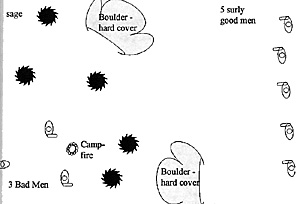
Back to The Gauntlet No. 14 Table of Contents Back to The Gauntlet List of Issues Back to Master Magazine List © Copyright 1998 by Craig Martelle Publications This article appears in MagWeb (Magazine Web) on the Internet World Wide Web. Other military history articles and gaming articles are available at http://www.magweb.com |
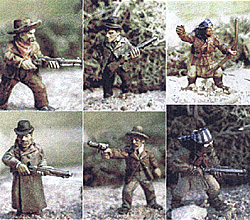 I. Handfuls of Dice, as you may have guessed, uses lots of dice. However, all dice have six sides and most of the time your opponent will be rolling dice against yours. This way, it keeps both players (or should I say, all the players) involved and contributing. The turn sequence is a little unconventional in that each player only gets one chance to get activated per turn. Otherwise, actions will be dictated by dice rolls, modified with a minimal number of modifiers, that will carry across all actions as you'll see.
I. Handfuls of Dice, as you may have guessed, uses lots of dice. However, all dice have six sides and most of the time your opponent will be rolling dice against yours. This way, it keeps both players (or should I say, all the players) involved and contributing. The turn sequence is a little unconventional in that each player only gets one chance to get activated per turn. Otherwise, actions will be dictated by dice rolls, modified with a minimal number of modifiers, that will carry across all actions as you'll see.
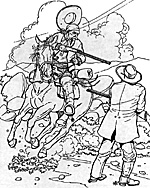 III. Personality figures.
III. Personality figures.
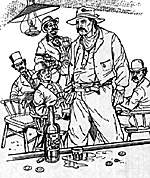 3. Once sequence is determined a character can Disengage or Fight (hand-to-hand), or Engage (move to fight (no attack that turn)), Fight (with ranged weapon), or Move (run away, reposition, etc). Attacks will be one of two types - hand-to-hand or ranged. Hand-to-hand is combat at close quarters with hand-held (or no) weapons. Ranged combat is adversaries attacking each other from a distance - that is, with thrown or fired weapons.
3. Once sequence is determined a character can Disengage or Fight (hand-to-hand), or Engage (move to fight (no attack that turn)), Fight (with ranged weapon), or Move (run away, reposition, etc). Attacks will be one of two types - hand-to-hand or ranged. Hand-to-hand is combat at close quarters with hand-held (or no) weapons. Ranged combat is adversaries attacking each other from a distance - that is, with thrown or fired weapons.
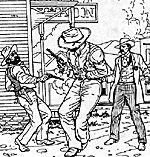 3d. Ranged Combat: Initiative is rolled only if defender is returning fire. Defender may move during attack (but suffers to hit penalties as shown on the chart below). A ranged attack on a defender behind cover prevents defender from attacking that turn.
3d. Ranged Combat: Initiative is rolled only if defender is returning fire. Defender may move during attack (but suffers to hit penalties as shown on the chart below). A ranged attack on a defender behind cover prevents defender from attacking that turn.
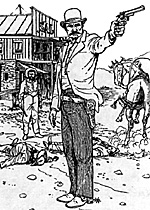 Defense Table - (because we all love to roll dice) Numbers are base and modifiers (+ and - on the table) added as applicable - Defense Dice cannot go below 1 (defender always has a chance).
Defense Table - (because we all love to roll dice) Numbers are base and modifiers (+ and - on the table) added as applicable - Defense Dice cannot go below 1 (defender always has a chance).
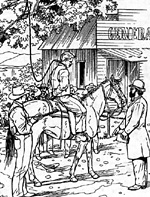 1. Engage: A character can move up to half his/her movement and still attack, although the penalty for this is -1 d6.
1. Engage: A character can move up to half his/her movement and still attack, although the penalty for this is -1 d6.
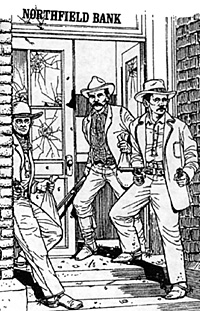 The reason I throw in this rule is for my friend Mark Hannam. Wargamer's traditionally like the comaraderie they develop with their fellows. Under this rule, the free for all during the game takes place. This is role playing. This is coercing your friend to get you a beer and you won't shoot his bar wench on this turn. Or with hearty calls of "I'll spare the kid's life if you drop your guns and walk away..." Sure.
The reason I throw in this rule is for my friend Mark Hannam. Wargamer's traditionally like the comaraderie they develop with their fellows. Under this rule, the free for all during the game takes place. This is role playing. This is coercing your friend to get you a beer and you won't shoot his bar wench on this turn. Or with hearty calls of "I'll spare the kid's life if you drop your guns and walk away..." Sure.